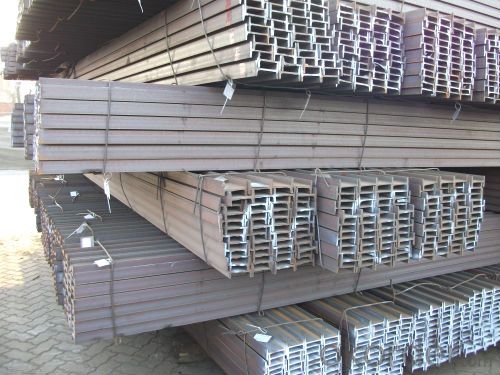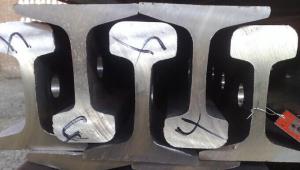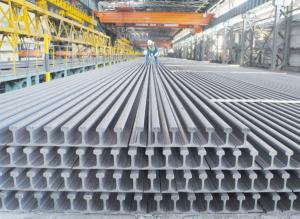Light Steel Rail Q235, 55Q with High Quality for Construction
- Loading Port:
- China main port
- Payment Terms:
- TT or LC
- Min Order Qty:
- 25 m.t.
- Supply Capability:
- 100000 m.t./month
OKorder Service Pledge
OKorder Financial Service
You Might Also Like
Product Description of Light Steel Rail Q235, 55Q with High Quality for Construction:
Sizes: 38kg, 43kg, 45kg, 50kg, 60kg.
Production Standard: GB2585-81, DIN, AREMA, JIS, BS, UIC, etc.
Material: 50MN, U71MN, 900A, 110A, etc.
Length: 6m-25m according to the requriements of the clients
Usages of Light Steel Rail Q235, 55Q with High Quality for Construction:
Light rail is mainly used in forest region, mines, factories and construction sites laid of the place such as temporary transport line and light motorcycles with line. Be widely used for railway, subway, transportation track, express, curve way, tunnel way and so on.
Packaging & Delivery of Light Steel Rail Q235, 55Q with High Quality for Construction:
1. Packing: it is nude packed in bundles by steel wire rod
2. Bundle weight: not more than 3.5MT for bulk vessel; less than 3 MT for container load
3. Marks:
Color marking: There will be color marking on both end of the bundle for the cargo delivered by bulk vessel. That makes it easily to distinguish at the destination port.
Tag mark: there will be tag mark tied up on the bundles. The information usually including supplier logo and name, product name, made in China, shipping marks and other information request by the customer.
If loading by container the marking is not needed, but we will prepare it as customer request.
4. Transportation: the goods are delivered by truck from mill to loading port, the maximum quantity can be loaded is around 40MTs by each truck. If the order quantity cannot reach the full truck loaded, the transportation cost per ton will be little higher than full load.
5. Delivered by container or bulk vessel
6. Delivery Time: All the Hot Rolled Steel Rail will be transpoted at the port of Tianjin, China within 30 days after receiving the advance payment by T/T or the orginal L/C at sight.
Inspection of Light Steel Rail Q235, 55Q with High Quality for Construction:
We will send the MTC of the factory to the clients dirrectly which contain the anlisis of the heat, chemiqul composition, phisical characteristicas, etc.
And our inspectors will arrive at the factory to meke the inspection of the size, length, weight and quantity before the transportation from the factory.
FAQ:
Q1: How soon can we receive the product after purchase?
A1: Within three days of placing an order, we will begin production. The specific shipping date is dependent upon international and government factors, but is typically 7 to 10 workdays.
Q2: How do we guarantee the quality of our products?
A2: We have established an advanced quality management system which conducts strict quality tests at every step, from raw materials to the final product. At the same time, we provide extensive follow-up service assurances as required.
Q3: Why buy Materials & Equipment from OKorder.com?
A3: All products offered by OKorder.com are carefully selected from China's most reliable manufacturing enterprises. Through its ISO certifications, OKorder.com adheres to the highest standards and a commitment to supply chain safety and customer satisfaction.
Images:


- Q: How are steel rails affected by changes in track alignment?
- Steel rails can be affected by changes in track alignment, which can lead to various consequences. Initially, sudden shifts or misalignments in the track can exert excessive stress on the steel rails, causing them to wear down more quickly. This can result in cracks, breaks, or deformations in the rails, which undermines their structural integrity. Furthermore, alterations in track alignment can also impact how forces are distributed on the steel rails. When the track alignment is not smooth, the weight of the train and the forces generated during its movement may not be evenly spread across the rails. Consequently, certain sections of the rails may bear more weight, leading to accelerated wear and the possibility of rail failure. Additionally, changes in track alignment can influence the overall stability and comfort of train rides. Misaligned tracks can produce excessive vibrations and impacts, which can cause discomfort for passengers and harm to the rolling stock. This can result in higher maintenance costs and decreased operational efficiency. Moreover, changes in track alignment can affect the safety of train operations. Misaligned tracks can heighten the risk of derailments, especially when trains are traveling at higher speeds. Proper track alignment is crucial for ensuring the safe and efficient movement of trains, and any deviations from the desired alignment can compromise the overall safety of the rail system. Overall, changes in track alignment can have negative effects on steel rails, including increased wear and tear, compromised structural integrity, uneven distribution of forces, reduced stability and comfort, and potential safety hazards. Therefore, regularly monitoring and maintaining track alignment is essential to guarantee the longevity, efficiency, and safety of steel rails in railway systems.
- Q: Are steel rails used in freight train operations?
- Yes, steel rails are commonly used in freight train operations. Steel rails provide a durable and strong track infrastructure that can handle the heavy loads and constant use of freight trains. They are able to withstand the weight of the train cars, the impact of the wheels, and the forces applied during braking and acceleration. Steel rails also offer stability and a smooth surface for the train to travel on, ensuring safe and efficient freight train operations. Additionally, steel rails require less maintenance compared to other materials, making them a cost-effective choice for freight train networks.
- Q: Can steel rails be easily damaged by external factors?
- No, steel rails are not easily damaged by external factors. They are designed to withstand harsh weather conditions, heavy loads, and impacts from passing trains.
- Q: How are steel rails protected against wear caused by train wheels?
- Steel rails are protected against wear caused by train wheels through regular maintenance practices such as grinding, lubrication, and periodic replacement. Additionally, the use of high-quality steel and proper alignment of the tracks helps to minimize wear and extend the lifespan of the rails.
- Q: Can steel rails be used for underground tunnels?
- Yes, steel rails can be used for underground tunnels. Steel rails are commonly used in underground tunnel construction for the tracks that support trains or other transportation systems. They provide stability, durability, and a smooth surface for the vehicles to travel on.
- Q: Can steel rails be used in heritage or tourist railways?
- Steel rails are indeed suitable for use in heritage or tourist railways. They are, in fact, the most commonly employed type of rails in railway tracks worldwide, including those found in heritage and tourist railways. Steel rails possess numerous advantages, including durability, strength, and resistance to wear and tear, which render them ideal for heavy-duty usage. These characteristics ensure the ability of steel rails to support the weight of locomotives and rolling stock, thereby guaranteeing safe and dependable operations. Moreover, steel rails necessitate relatively minimal maintenance, which is particularly crucial for heritage or tourist railways that may possess limited resources for upkeep. Consequently, steel rails present a cost-effective and dependable solution for heritage or tourist railways, enabling them to offer visitors an authentic and pleasurable railway experience.
- Q: Can steel rails be used for roller coasters?
- Yes, steel rails are commonly used for roller coasters due to their strength, durability, and smoothness, allowing for thrilling and safe rides.
- Q: What are the safety regulations associated with steel rail transportation?
- Safety regulations associated with steel rail transportation are put in place to ensure the safe and efficient movement of goods and passengers. These regulations cover various aspects of the rail transportation system, including infrastructure, equipment, operations, and emergency preparedness. One of the key safety regulations is the regular inspection and maintenance of rail tracks. Rail companies are required to conduct regular inspections to identify any defects or damages on the tracks that may compromise safety. This includes checking for worn-out rails, loose fasteners, and any other potential hazards. Additionally, regular maintenance activities such as track repair and replacement are undertaken to ensure the tracks are in optimal condition. Rail transportation safety regulations also require the use of reliable and well-maintained rolling stock. Trains must undergo regular inspections to ensure that all components, such as brakes, couplers, and locomotive engines, are in proper working order. Regular maintenance and repair activities are crucial to prevent equipment failures that could lead to accidents. Train operators are required to follow specific safety protocols and regulations. This includes adhering to speed limits, following signal indications, and maintaining proper spacing between trains. Operators are also required to undergo training and certification to ensure they have the necessary skills and knowledge to operate trains safely. Emergency preparedness is another important aspect of rail transportation safety regulations. Rail companies must have emergency response plans in place to address potential accidents or incidents. This includes having trained personnel, emergency communication systems, and necessary equipment to respond promptly to any emergencies that may occur. In addition to these specific regulations, rail transportation safety is also influenced by general transportation safety regulations. For example, rail companies must comply with regulations related to hazardous materials transportation if they transport such goods. This includes proper packaging and labeling of hazardous materials, as well as following specific procedures for handling and transporting them. Overall, the safety regulations associated with steel rail transportation aim to prevent accidents, protect the well-being of passengers and workers, and ensure the safe and efficient movement of goods. These regulations are continuously updated and improved to address emerging risks and technologies in the rail transportation industry.
- Q: What are the potential risks of using steel rails in corrosive environments?
- Using steel rails in corrosive environments can pose several potential risks. Firstly, steel is susceptible to corrosion when exposed to certain elements, such as moisture, saltwater, and chemicals. In corrosive environments, such as coastal regions or areas with high levels of industrial pollution, these elements can accelerate the corrosion process. Corrosion weakens the integrity of the steel rails, making them more prone to damage and failure. Secondly, corrosion can lead to the formation of rust on the steel rails. Rust is a reddish-brown oxide that forms when iron reacts with oxygen and moisture. As rust accumulates on the rails, it can cause surface irregularities, pitting, and roughness. This can result in a decrease in the overall performance of the rails, leading to issues such as increased friction, noise, and vibration during train operations. Furthermore, as corrosion progresses, it can cause the steel rails to thin and weaken, potentially compromising their structural integrity. This can increase the risk of rail buckling or breakage, which can be hazardous for trains and their passengers. In extreme cases, the corrosion may reach a point where it weakens the rails to such an extent that they can no longer support the weight of the trains, leading to derailments and accidents. Another potential risk of using steel rails in corrosive environments is increased maintenance and replacement costs. Corrosion requires regular inspection, cleaning, and protective coating to prevent further damage. These maintenance activities can be time-consuming and expensive. Additionally, the need for frequent replacement of corroded rails can result in higher costs for rail operators and potentially disrupt train schedules. In conclusion, the potential risks of using steel rails in corrosive environments include accelerated corrosion, the formation of rust, decreased rail performance, compromised structural integrity, increased risk of accidents, and higher maintenance and replacement costs. It is crucial for rail operators to implement corrosion prevention and maintenance strategies to mitigate these risks and ensure the safe and efficient operation of rail systems in corrosive environments.
- Q: What are the safety precautions when working with steel rails?
- When working with steel rails, it is important to follow several safety precautions. Firstly, wearing appropriate personal protective equipment (PPE) such as safety glasses, gloves, and steel-toed boots is essential to protect against potential hazards. Secondly, workers should be trained on proper handling techniques to avoid strains and injuries. It is crucial to use lifting equipment and proper body mechanics when moving heavy rails to prevent back injuries. Additionally, workers should be cautious of sharp edges and potential tripping hazards, ensuring a clean and organized work area. Finally, regular inspections and maintenance of the rails, including checking for any cracks or defects, should be conducted to ensure safe working conditions.
Send your message to us
Light Steel Rail Q235, 55Q with High Quality for Construction
- Loading Port:
- China main port
- Payment Terms:
- TT or LC
- Min Order Qty:
- 25 m.t.
- Supply Capability:
- 100000 m.t./month
OKorder Service Pledge
OKorder Financial Service
Similar products
Hot products
Hot Searches
Related keywords

























